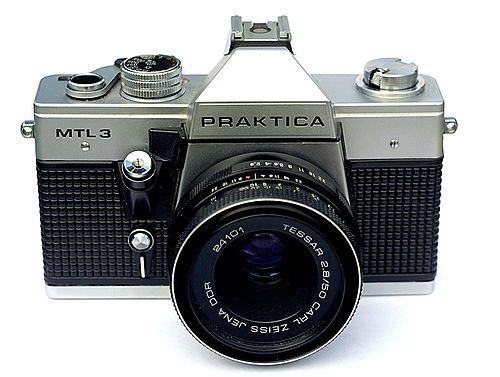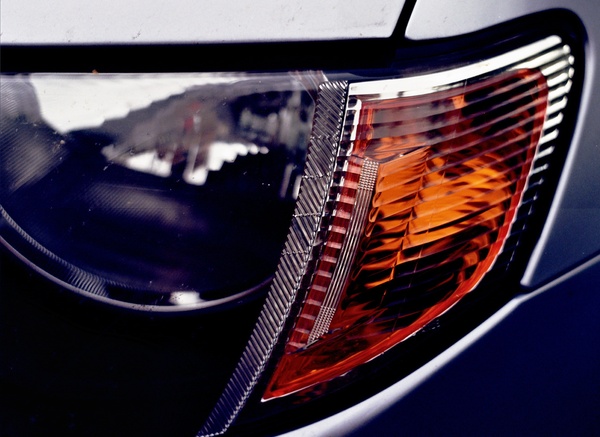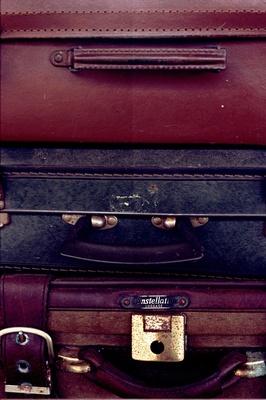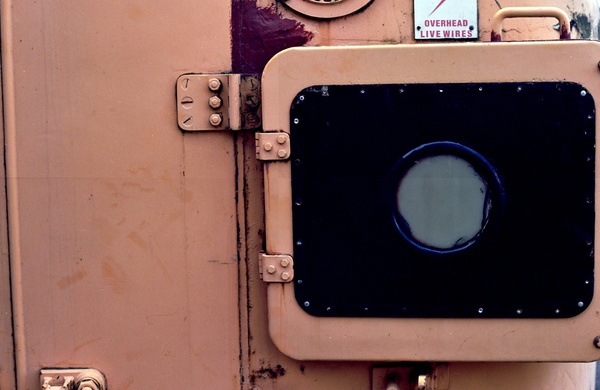
from Shutter, by Lewis Collard

This is the Praktica MTL3 (variously spelled with or without a space), a pretty crude, and awesomely reliable, SLR camera, of which over eight hundred thousand were built from 1978 to 1984.
There's an identical camera out there calling itself the Foticon MTL3. There was also a British-market-only version, made from 1984 to 1986, with no self timer, but is otherwise a nearly identical camera to what I describe here.
If you're just here for the manual, it's here, and if you want a human-readable user's guide it's over here on wikiHow.

Colours. Praktica MTL3 and Pentacon 50mm f/1.8
shooting Fuji Pro 160S, push-processed to ASA 400.
Metal. Most of them have a raised-grid grip; a couple have smooth leatherettes, like Matt Denton's did.
The shutter button is right where you want it for comfort: on the front, and pointing at about forty-five degrees rather than straight up. This might even be the first shutter button to be angled like this. Beware: there's no way to disable the shutter button, so you should probably store it with the film not wound on.
It weighs about 560 grams, which is less than an inferiorly-constructed Canon A-1 of the same era.

Point. Praktica MTL3 and Pentacon 50mm f/1.8
shooting Fuji Pro 160S, pushed to ASA 400.
Metal focal plane shutter, speeds from 1 second to 1/1000 in half stops (plus "Bulb", and a separate position for electronic flash sync). This is an awesome sounding thing. Think a Nikon D2H with the volume turned up to 11, plus a bit more. I'm not kidding when I tell you that I was photographing a goat, and that the shutter noise was so loud that it startled the goat. That was with a 300mm lens, to give you some idea of how far away I was.
I think the shutter sound and feel might be the best thing about this camera. It is very reassuring to feel that through your fingers. On the other hand, there's quite a lot of vibration, and that might suck for tripod-mounted exposures of less than a second. Hand-held exposures are so fast that the vibration doesn't matter; longer exposures mean that the time the vibration is happening is irrelevant compared to the length of the exposure. Oh, who cares about that shit anyway; I haven't tested this, and besides, Click-CLICK! :D
On the downside, the mirror slap will send every seismometer in a five mile radius bezerk, plus you'll end up with blurry pictures. For exposures from about 1/15 to 1 second, I'd recommend stopping down a lot to get a longer exposure to make up for this.
The shutter button takes standard threaded cable releases, hooray.

G. Praktica MTL3 and Pentacon 50mm f/1.8
shooting Kodak Ektar 100, pushed to ASA 400.
There's no kind of flash automation at all. Still, if you want to nuke things with direct flash, any old 1970s/1980s auto-thyristor electronic flash gun will do the trick just fine. Use Ken Rockwell's tricks for using fill flash on old cameras if you want fill for daylight.
Flash sync with electronic flashes is "about" (from the manual) 1/125; that's the little lightning bolt setting on the shutter speed dial. That's twice as fast as my Canon A-1 from the same era, and much faster than the very professional Nikon F3 of 1980, and nearly 30% faster than the professional Canon New F-1 of 1981. Huzzah!
It even has a shutter speed position for fast-burning flash bulbs! Turn the shutter speed dial to the little bulb icon for this; I think (but I'm not sure) that it sets the shutter speed to 1/30.

Headlight. Praktica MTL3 and Pentacon 50mm f/1.8
shooting Kodak Ektar 100, pushed to ASA 400.
Manual. Also, the best-feeling and most reassuring advance of any camera I've ever used, to match the shutter.
Through-the-lens, centre-weighted. To turn on the meter, you push the big black lever next to the lens mount. This stops down the lens to the aperture you select, and you adjust the aperture, shutter speed or both until the needle indicates a correct exposure (when it's hanging around the middle). Primitive, but it works, and has the handy side-effect of working around any aperture miscalibration. Some other Praktica cameras like the LTL 3 give you open-aperture metering, but this one doesn't.
The manual is awesome; it makes it sound like a much more advanced camera than it really is. It talks about the MTL3's "Automatic exposure control system". I don't know how they consider "adjust both shutter speed and aperture manually" to be "automatic". Oh, I love camera manufacturers.
It's good for films from ASA 12 up to 1600.

Suitcases. Praktica MTL3 and Pentacon 50mm f/1.8
shooting Kodak Ektar 100, pushed to ASA 400. The vertical line is an
artifact of push-processing.
The MTL3 uses the once-very-common M42 screw mount. Always be very careful about screwing in a lens for the first couple of threads; you don't want to cross-thread the mount. The best way of mounting an M42 lens is to lay the camera facing upwards on your lap. Line up the lens and then spin it rapidly. Don't apply any downward force; it's not necessary and it increases the risk of cross-threading.
Sounds scary, but it's not. Do it once or twice and you'll get the hang of it. The M42 mount might be derided for requiring lots of spins, but you'll be able to change lenses in total darkness. You don't have to line up any silly dots, either; just spin it until the thread bites. (The downside is that a sticky focus ring will cause a lens to come undone.)
On compatibility: All M42 lenses that I know of should work just fine and dandy on the MTL3. If your lens has an automatic aperture (you can identify these lenses by the big pin on the back, which stops down the aperture when shooting), the MTL3 will use it; if it doesn't, or has an M/A switch, it'll work just fine with that, too.

V. Praktica MTL3 and Pentacon 135mm f/2.8
shooting Kodak Ektar 100, pushed to ASA 400. It's divided into 4 because
that's what Ektar does when pushed. Interesting.
M42 lenses are a mixed bag. The following boils down to this: Buy Eastern European (which are usually copies of old, trusty German designs) or buy Pentax. Everything else might be crap. Even the best of the Eastern European ones could turn out to be dogs, because of massive variation between samples. The recommendations below are either what I've used personally or what people I hold in high regard would recommend. I'd welcome your own recommendations.
For serious cheapskates: The lens that typically sold with this camera (the Meyer-Oreston/Pentacon 50mm f/1.8) is fine, although it's hilariously soft in the corners wide-open (so soft that you can see it through the viewfinder!). There's an absurdly detailed article over here. The Helios 44M-series 58mm lenses are surprisingly good for their very low price. The Industar 50mm f/3.5 pancakes are Tessar-type lenses that work fine. You can any of these for less than £20 if you look around.
For cheapskates: The cheaper Carl Zeiss Jena lenses are all well-regarded. The Pentacon 135mm f/2.8 (£40 on eBay as I write this) is super and renowned for extremely smooth bokeh, such that it is nicknamed the "bokeh monster", and for very good reason: it is truly insane. It's a bit soft, but that only makes it a more ideal portrait lens. I haven't used the Pentacon 29mm f/2.8 all that much, but used prices are currently twice what I paid a year and a half ago, which might be a recommendation, I suppose.
For the rich: Just kidding. Any M42 lens will cost you half an order of magnitude less than their equivalents on modern lens mounts. The Super Takumar (Pentax) 50mm f/1.4 is very well regarded by people whose opinions I value, as are all other Takumar lenses. The Zeiss Flektogon wide-angles are pretty good by all accounts.
For weirdos: There's a Sigma 55-200mm f/4.5 autofocus zoom out there. You read that right. I have no idea how that works, but there's a few out there. I recall it being listed on eBay, and the fellow who bought that particular one might well have made an appearance at the end of this thread here (if John Winterbourne, or anyone else that has one of these, would like to give me more details I'll gladly publish them here).
For nobody: Stay away from pseudo-brands like Hanimex, Paragon, Prinzflex, Sirius, and so on. Good M42 lenses are so cheap that it's not worth economising. Get some nice Eastern European glass for very little extra money. Stay clear of zooms.
Veijo Vilvia has a number of tests of many M42 lenses here (search ahead for "M42 lenses"). He also does cool stuff like modifying lenses from 1915 to work on his digital SLR. Cool? Very. Also MFLenses.com is OK.

Headlight, II. Praktica MTL3 and Pentacon 50mm f/1.8
shooting Kodak Ektar 100, pushed to ASA 400. A present for the train geeks out there.
Massive, bright SLR pentaprism with split-image and microprism focusing aids. Only one thing which isn't your image: a needle on the right hand to indicate under- and over-exposure. Also, if your film is not wound on, there's a tiny triangle in the left-hand side of the viewfinder to remind you. This is super! I love simple viewfinders; it's part of why my Canon A-1 is so great. I prefer the LCD digits of the A-1 because they're easier to see in the dark. On the other hand, the MTL3 can only automatically time out exposures to 1 second, so it's not like you'll worry about this too much in the real world.

Guard. Praktica MTL3 and Pentacon 50mm f/1.8
shooting Kodak Ektar 100, pushed to ASA 400. Push-processing artifacts strike
again! I might try pushing it to 200 next time.
One single 1.35v PX625 mercury cell. Oh noes! You can't get these anymore. On the other hand, my favourite camera repair place (now gone) said that 1.5v batteries will work, and cause a mere seventh of a stop exposure inaccuracy. All the shots here were taken with a year-old 1.5v battery (I bought it, fitted it, then didn't use the camera for a while). If you're paranoid and need something very close to the proper 1.35v voltage, there's a couple of options: get a Wein PX625 cell for a few quid, or cheap out and modify a 675 zinc-air cell.
If you're hardcore, the MTL3 works fine without a battery. The battery only powers the meter; everything else is mechanical.
Indestructible. I should feel bad about the abuse that my camera has suffered, but it's manly enough to take it. Far better than you'd expect from an Eastern Bloc camera (hello, Kiev), and as good as or better than any other camera I've used. The great thing about this camera's simplicity (or crudeness) is that there is very little that cannot be fixed by an expert technician without requiring spare parts. If your T90 toasts an electronic component, you're dead.
The light seals don't turn into goo after a couple of decades like they do on lesser cameras. Matt Denton says it's because they're actually made (partly) of string. Neat.
There are issues with the MTL3 that affect all cameras to some extent, more often than not caused by people dismantling them and not putting them back together again. I've also heard about a few shutters sticking open, meters stopping working, which means that, after three decades, these crude East European cameras are going wrong about as often as two-year-old digital SLRs. Hooray! On the other hand, Steven Gandy berates them here as having a "poor reputation for reliability". Strange, and you should probably pay more attention to an expert like him than a random guy like me.
The MTL3 works just fine in way-the-hell-below-zero (Minnesotan winter) temperatures, even if your battery might not.

A. Praktica MTL3 and Pentacon 50mm f/1.8
shooting Fuji Pro 160S, pushed to ASA 400.
If you need a fully-manual camera, do it. There may be a few tougher and better cameras in this field, but none are such insanely great value for money as the MTL and friends. If you can't find one, look around for an MTL5, TL3, Super TL1000, DTL5 or MTL50, which are nearly identical cameras.
eBay, as usual, is the best place to get them. They're extraordinarily cheap; bodies often sell for less than £20 as I write this. Mine cost about £10 two years ago. If you want a fully-manual camera, or your work mandates having the toughest camera around, you can't go wrong with it.

Tyre. Praktica MTL3 and Pentacon 50mm f/1.8
shooting Fuji Pro 160S, pushed to ASA 400.
I'll take this opportunity to recommend the
Norfolk Camera Centre [dead link], who
did an incredible job of servicing the three Pentacon M42
lenses that I sent to them that I've used in this article. No, I don't
receive a penny for plugging them; I'm doing it because the repair guy there
is insanely great and he knows his stuff.
Also thanks to Monica, who borrowed this camera for several months, for spotting several typos and grammatical errors in this piece. :)